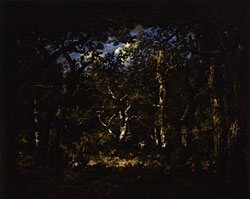Between 1830 and 1880 a loosely associated group of landscape painters lived and worked in the small farming village of Barbizon, France. Rejecting the traditional artistic conventions of academic landscape painting, such as the Ideal, the Pastoral, and the Heroic, they strived instead to depict an unmediated version of nature — an approach that would prove central to later avant-garde movements such as Impressionism.
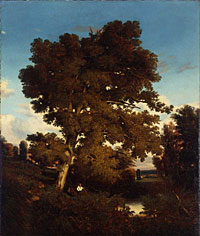
In May the Mildred Lane Kemper Art Museum at Washington University in St. Louis will revist this period with The Barbizon School and the Nature of Landscape. Curated by Rachel Keith, associate registrar for exhibitions, the show is drawn primarily from the museum’s permanent collection and features close to 40 works — including paintings, drawings and prints — by leading Barbizon figures as well as by later French and American artists who were influenced by the school. In addition, the exhibition will present a small selection of travel guides and mass literature depicting popular notions of the Barbizon region. Taken together, these materials will explore how Barbizon artists were both entrenched within and struggled against the commodification and commercialization of nature.
The collection of the Kemper Art Museum, which dates back to 1881, has historically focused on the work of contemporary artists and many of the paintings on view in The Barbizon School were acquired shortly after their creation. For example, Julien Dupré’s In Pasture (1882) was purchased by subscription in 1886, while Dwight William Tryon’s Before Sunrise (Morning Twilight, at Daybreak) (1906-07) was purchased in 1910. More than a dozen other works arrived in 1905 as part of a major bequest from St. Louis banker Charles Parsons. Notably, several of these paintings have recently undergone conservation to remove old, yellowed varnish, in order to reveal the original intensity of color.
THE BARBIZON SCHOOL
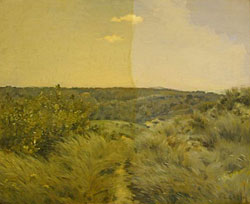
Barbizon and the surrounding area appealed to members of the Barbizon School both for its diverse landscapes and for its reputation as an unspoiled natural haven, which the artists believed would allow them direct, unmediated experiences of nature. In fact the pristine quality of the area was largely fictionalized, part of efforts to bolster a fledgling tourist industry that was developing in response to growing popular demands for all things nature-related. For 19th-century audiences desperate to escape the perceived artificiality of urban life, the rural scenes of the Barbizon artists — often depicting man and nature in harmonious relationship – seemed to offer a much-desired antidote to the ills of modern industrialization.
The first section of the exhibition highlights many of the Barbizon School’s core members and offers a representative sampling of the group’s aesthetic themes and concerns. These include simple, straightforward scenes of nature, ranging from mysterious forests to bucolic fields, as well as images of the rural countryside, with its peasants and flocks of sheep — all painted with an emphasis on the effects of light and atmosphere. For example, Jules Dupré’s The River (c. 1850) is a dramatic, almost elegiac composition depicting a sun-lit oak jutting over a pitched riverbank. Wood Interior (1867), by Narcisse Virgile Diaz de la Peña, is a large sous-bois (or forest undergrowth) scene in which densely packed brushstrokes mimic the color and texture of leaves, soil, bark and rock.
Jean-Baptiste-Camille Corot — perhaps the group’s best known member today — is represented by Le Chemin des Vieux, Luzancy, Seine-et-Marne (The Path of the Old People) (1871-72), a painterly scene typical of the group’s plein-air style, which depicts an elderly man and woman passing through a small copse of trees. Other artists in the section include Jean Charles Cazin, Charles François Daubigny, François Louis Français, Henri Harpignies, Charles Emile Jacque, Emile van Marcke de Lummen, Jean-François Millet, Léon Germain Pelouse, Theodore Rousseau and Constant Troyon.
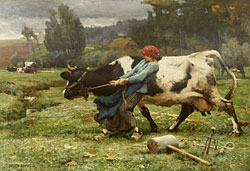
THE BARBIZON LEGACY
The exhibition’s second section explores the broad impact of the Barbizon School, which reached from Impressionists such as Camille Jacob Pissarro to later French Salon painters such as Léon Lhermitte and Julien Dupré. For example, Lhermitte’s large oil La Moisson (The Harvest) (1883) — viewed by thousands at the Paris World’s Fair in 1889 — depicts a group of humble agricultural workers in a golden, scrupulously rendered hayfield, while Dupré’s meticulously observed Haying Scene (1882), like his aforementioned In Pasture, is notable for the artist’s bravura brushwork.
Barbizon painters also exerted a powerful influence on their American contemporaries. In New England Village (Catskill Cove) (1866), George Inness — who visited Barbizon in the mid-1850s — integrates Hudson River School romanticism with the Barbizon School’s looser brushwork and darker palette. Conversely, the softened focus and subtle values of Tryon’s Before Sunrise distill the Barbizon approach through the lens of Impressionism and Tonalism. Other American artists represented include Asher B. Durand, Sanford R. Gifford, Winslow Homer, William Henry Howe, Eastman Johnson, John F. Kensett, Theodore Robinson and Alexander Helwig Wyant.
MILDRED LANE KEMPER ART MUSEUM
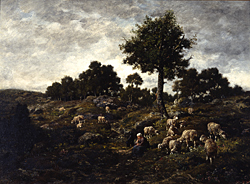
The Kemper Art Museum is the oldest art museum west of the Mississippi River and boasts one of the finest university collections in the United States, with important paintings, sculptures, photographs and installations by 19th-, 20th- and 21st-century American and European artists. In addition, as part of Washington University’s Sam Fox School of Design & Visual Arts, the museum is committed to furthering critical thinking and visual literacy through a vital program of exhibitions, publications and accompanying educational programs. The Barbizon School and the Nature of Landscape is presented as part of the museum’s Focus series, which explores a theme, an individual work or a group of works drawn from the permanent collection.
The Barbizon School and the Nature of Landscape will open with a reception from 7 to 10 p.m. Friday, May 2, in the Mildred Lane Kemper Art Museum’s Barney A. Ebsworth Gallery, and remain on view through July 21. Both the reception and the exhibition are free and open to the public.
The Kemper Art Museum is located on Washington University’s Danforth Campus, near the intersection of Skinker and Forsyth boulevards. Regular hours are 11 a.m. to 6 p.m. Mondays, Wednesdays and Thursdays; 11 a.m. to 8 p.m. Fridays; and 11 a.m. to 6 p.m. Saturdays and Sundays. The museum is closed Tuesdays. For more information, call (314) 935-4523 or visit kemperartmuseum.wustl.edu.
|
WHO: Mildred Lane Kemper Art Museum WHAT: Exhibition, The Barbizon School and the Nature of Landscape WHEN: May 2 to July 21. Opening reception 7 to 10 p.m. Friday, May 2. WHERE: Mildred Lane Kemper Art Museum, Washington University, near the intersection of Forsyth and Skinker boulevards. HOURS: 11 a.m. to 6 p.m. Monday, Wednesday and Thursdays; 11 a.m. to 8 p.m. Fridays; 11 a.m. to 6 p.m. Saturdays and Sundays. Closed Tuesdays. COST: Free and open to the public. INFORMATION: (314) 935-4523 or kemperartmuseum@wustl.edu |
